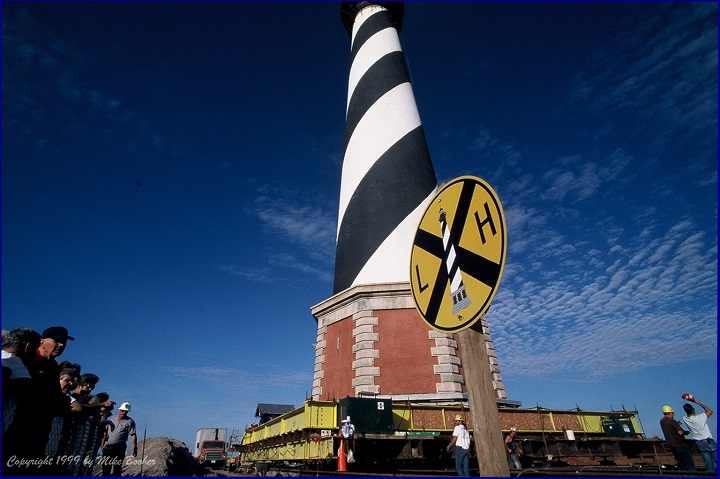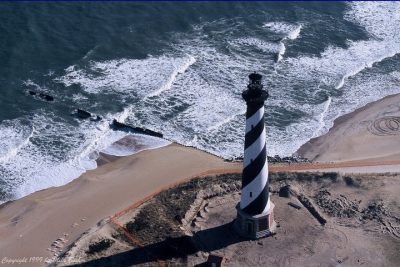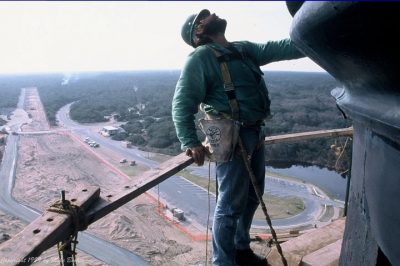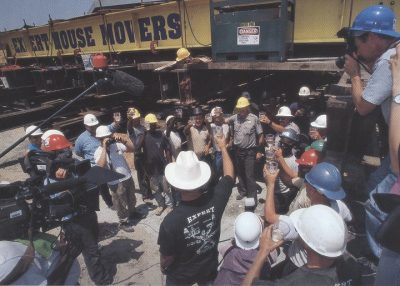
CAPE HATTERAS NATIONAL SEASHORE – On June 17, 1999, the Cape Hatteras Lighthouse began a journey rather than guided one.
Over the course of 23 days, the Cape Hatteras Lighthouse was relocated 2,900 feet to where it stands today because of the threat of shoreline erosion, the park service website states.
Supporter Spotlight
When Cape Hatteras Lighthouse was completed in 1870, the structure was 1,500 feet from the ocean but after a century of tides washing over the island, moving sand from oceanside to soundside, there was just 120 feet separating the lighthouse from the ocean.
Supporter Spotlight
In 1980, the National Park Service started planning for long-term protection. The park service began a three-year public input process and in 1987, reached out the National Academy of Sciences that submitted in 1988 a report recommending moving the lighthouse as the most cost-effective protection, according to the park service.
The move was debated for years until in 1996, North Carolina State University reviewed the report and then produced its report, Saving the Cape Hatteras Lighthouse from the Sea, in January 1997, also recommending moving the lighthouse. Funding was appropriated by Congress in fiscal year 1998.
In early 1999 before the lighthouse was moved, the principal keeper’s quarters, double keepers’ quarters, oil house, cisterns and sidewalks were relocated, with all the buildings being in the same relative position as they were originally.
Robert Woody was a park ranger during the time of the move and is to speak during the celebration July 1.
“What I remember most about the Cape Hatteras Lighthouse move is the people involved, from the planners and engineers, to the people who did the hard lifting for the project on a daily basis, to the volunteers and rangers that stood with the visitors who came to see ‘the lighthouse move,’ making sure that they were safe and informed about what was happening when it was happening,” Woody told Coastal Review Online.
He said that the workers seemed to “‘get it.’ They seemed to sense that this was special, that they were involved in something historic, that they were becoming part of the legacy of the Cape Hatteras Lighthouse beyond themselves, but on a state and national level.” Adding that each worker knew the mission, which was to move the lighthouse from Point A to Point B, safely and without incidence, did their individual job, and then helped out where needed afterwards. “It was awesome to witness the teamwork that was occurring, and the pride that they were taking. I’ll never forget that.”

The relocation project also provided an excellent opportunity to highlight historic preservation and the issue of coastal erosion for an interested public, he said. “The project occurred during the early years of the internet and was made available through its use, not just to those who came to the seashore to see what was happening, but to all nationwide who had access to the internet.”
There was a great deal of planning, Woody recalled, to get the lighthouse moved.
“I would estimate that planning and coordination took about eight years until it all came together with the appropriations in the 1997-1998 fiscal years,” he said.
Planning began immediately after the National Park Service received the results of the 1988 National Academy of Sciences, which originally explored 10 options to preserve the lighthouse. The state reviewed the options and, finding agreement with the academy, the park service opted to move the lighthouse.
To orchestrate the move, Woody said, they had to follow the bidding process, select a contractor, review their proposal for the move and go through several stages of planning, compliance and policy reviews with the engineers, planners and designers at the park service’s Denver Service Center and with the regional office in Atlanta.

Woody added that the $12 million needed for the project didn’t come with the decision to move but had to be appropriated by Congress, which took several years in itself.
John M. Havel of Salvo has been researching Cape Hatteras Lighthouse since 2003, first to build an accurate scale model of the lighthouse and then to write a “complete and accurate history of (one of) the most recognized, photographed lighthouses in America, which I am still researching and writing,” he told Coastal Review Online in an email.
He attended the 10th anniversary event in 2009, when he said he met many folks involved in the move. Since then, those contacts have shared with Havel “stories, artifacts, and (seriously) thousands of photographs taken of the move with me.”
From an historical perspective, moving the lighthouse saved the “magnificent architectural monument” for many generations to come to appreciate, to climb, to photograph and to marvel, but from the perspective of human achievement and engineering, “it is remarkable how ‘easily’ it was moved.”
“I personally know at least three locals – and there were many, many more – that would have sworn on their parents’ graves that the lighthouse was certain to break apart and crumble once they tried to lift or move it. In actual fact, the brilliant and brave men and women that planned and executed this feat had no qualms at all,” Havel said.
“Using simple mechanics and engineering they separated the 4,000- to 5,000-ton lighthouse from its base, lifted it into the air, and then pushed and rolled it half a mile southwest and out of harm’s way,” Havel explained. “Once lifted, the move took just 23 days, and then it was gently lowered onto its new foundation, where it now stands, safe and secure. Records, instruments and photographs show that not one out of the 1,250,000 bricks was cracked or broken during the move.”

To move the 198-foot tall structure from its 130-year-old granite and rubble foundation took more than clever engineering.
“Ironworkers, stone masons, bricklayers, welders, carpenters, surveyors and hundreds of laborers spent months of hard work to accomplish this monumental task. Those men and women should not be forgotten,” Havel said. “They worked to preserve a grand symbol of the islanders and their families that lived here 100 and more years ago, and those same families and generations to whom the lighthouse meant life or death on this fragile ribbon of sand.”
He said that of the community and its leaders, about half were solidly against the move, including filing lawsuits, protesting and threatening proponents.
Now, 20 years later, there are few residents still upset about the move but after seeing the lighthouse safely moved and opened for climbing once again, “many of the naysayers changed their opinions and are now happy – or at least accepting – that moving it was the right thing to do,” Havel said.
Visitors to the park from now through Oct. 14 can meet with rangers for daily interpretive programs. From Monday through July 9, the anniversary of the 23-day lighthouse move, expanded interpretive programming will take place on the grounds of Cape Hatteras Light Station.







